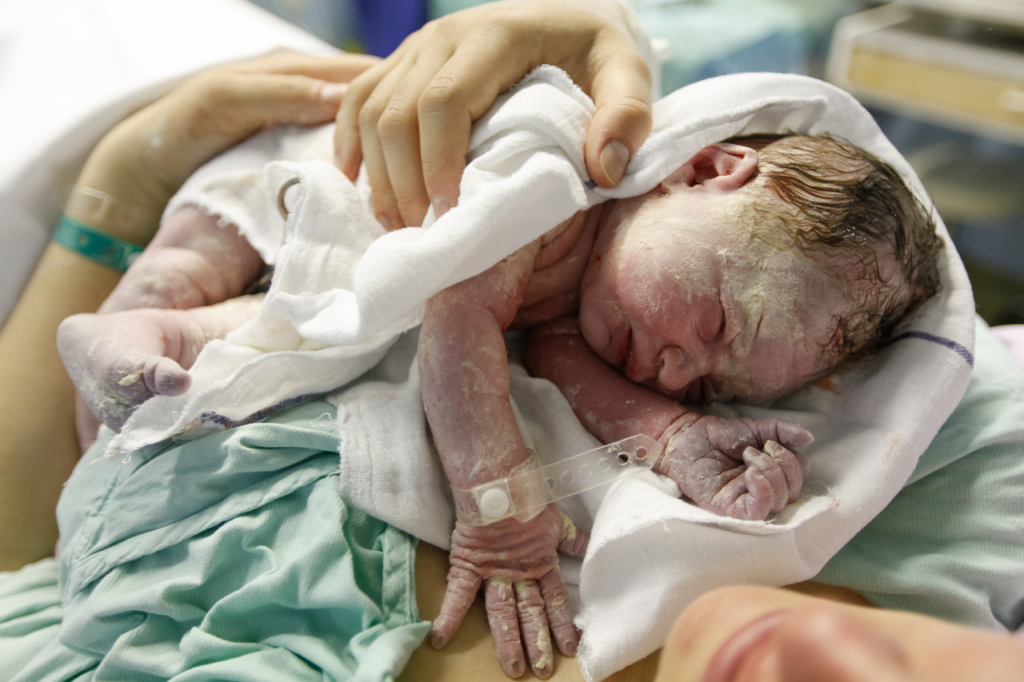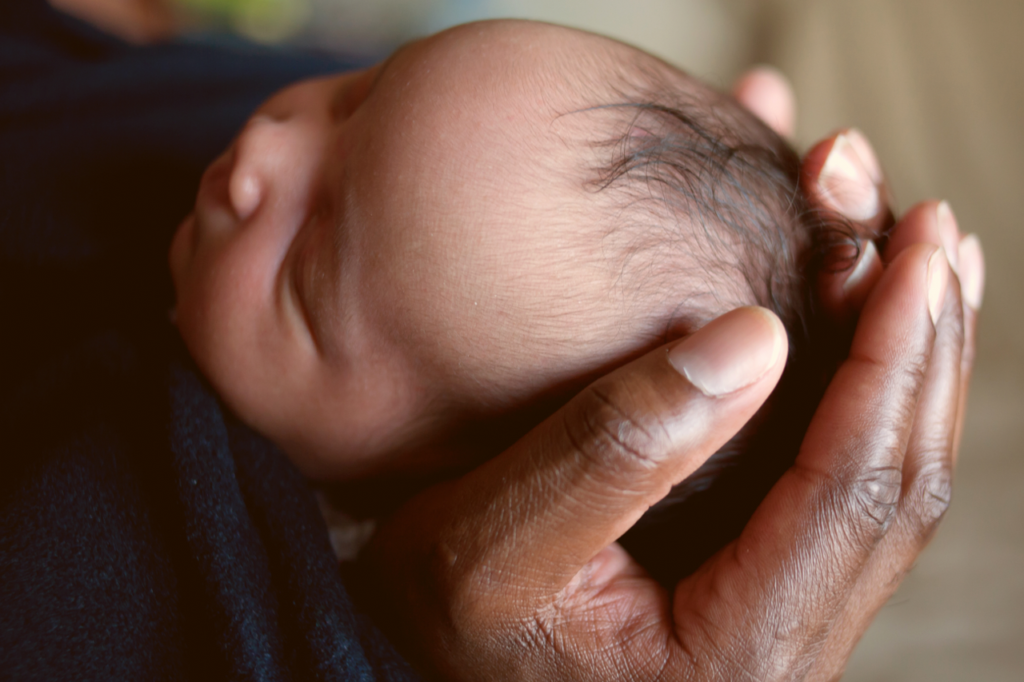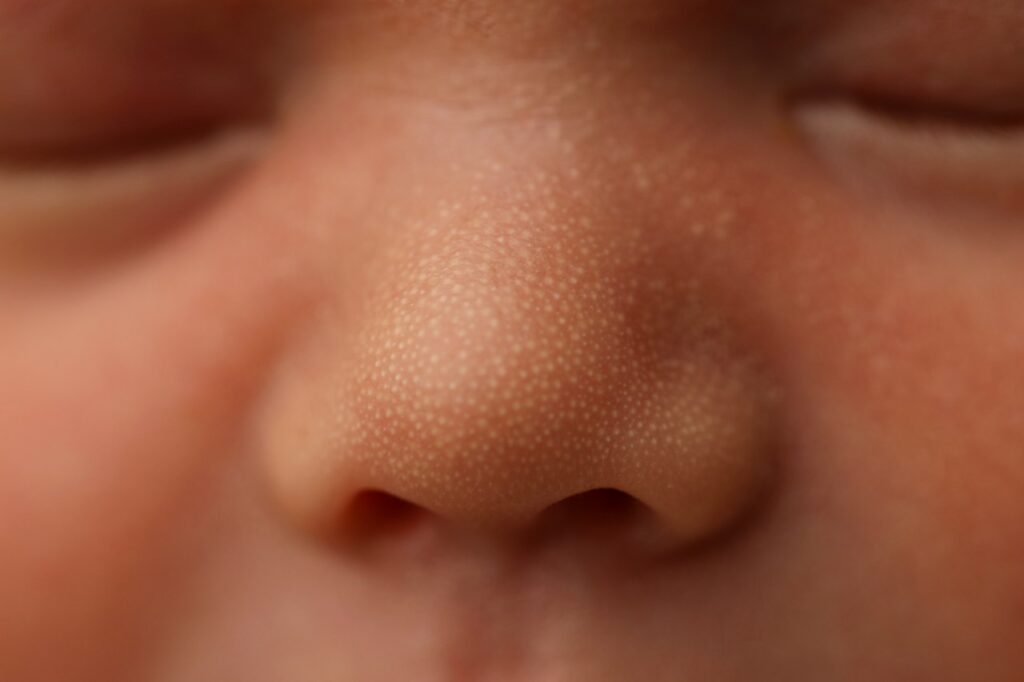The Naked Truth(literally): Newborn Bodies
Normal Newborn Characteristics
Your new little baby will be adorned with a variety of birth gunk upon arrival. It grosses many parents out, but it does serve a purpose. Upon further inspection, you might notice some rather interesting features from top to tail.
Keep in mind that a baby fresh out of the womb changes rapidly within the first few days and weeks so don’t panic – most of their newborn features are temporary and transient.
Mother Nature was highly intelligent when crafting a hormonal birth cocktail that promotes bonding, feelings of affection and a fierce sense of protection for your new little babe, milia and all!

Vernix
Vernix caseosa, usually just called vernix, means “cheesy varnish” in Latin. Also described as birthing custard or a cream-cheese like coating, all of these terms give a tantalizing description of a very common thick, white layer covering your baby at birth.
I know this disgusts many parents, but it is a really cool phenomenon unique to humans. It is made up of fats, protein and mostly water and contains sloughed off skin cells, shed hair (see lanugo below) and sebum.
It forms around 21 weeks gestation and aids in epidermal development that is completed by the beginning of the 3rd trimester.
Coverage varies but generally term babies have some at least in their fatty folds & creases while preterm infants might have more and postdates infants usually have little to none.
Useful functions include:
- waterproofing + moisturizing while floating in fluid
- lubing them up for the birth canal
- infection protection – antimicrobial + skin barrier
- temperature regulation post birth with a layer of insulation
- gut development from intra-uterine consumption
A baby friendly practice after they are born is for your healthcare team to gently rub the waxy goodness into their skin to help them stay warm & toasty vs. whisking them away to scrub it off which completely interrupts the afterbirth bonding nature intending.
Lanugo
Vernix and lanugo have a symbiotic relationship to aid in healthy fetal development.
Lanugo means “wool” in Latin, and it describes a fine, downy hair covering a baby. It is the first hair produced by their hair follicles, and it begins to develop in utero around 16 weeks. The primary purpose is the anchor the vernix to the skin so it can do it’s job effectively.

It is usually shed before birth- remember that the vernix mixture contains hair – and because babies are ingesting amniotic fluid, and everything floating in it, lanugo also makes up part of the first poop called “meconium”.
Some babies are born with some still on the body, usually at the temples, on the upper back or shoulders. It usually falls out within a few weeks and is replaced with thinner hair.
A few other mammals are born with this fine, downy hair, not just humans.
Why delay the 1st bath?
In addition to vernix, your baby might have other lovely fluids on them like amniotic fluid and a smattering of blood. It is very reasonable that you might want your baby cleaned up as soon as possible after birth for a clean cuddle.
Many depictions of birth show a shiny, swaddled baby, almost like a burrito topped with a beanie. The reality in a baby-friendly facility should not resemble food babies.
Why have we moved away from this practice? Most birth places will not bathe a baby within 12-24 hours or more after birth for a variety of reasons.
- your smells + tastes are on their hands which act as a guide to your nipples…seriously…DO NOT WASH IT OFF
- newborns have inborn reflexes to seek out the nipple ASAP after birth – separating them for a bath and then trapping their hands with a swaddle interferes with their innate need to do the “breast crawl”
- bathing drops their body temperature and then they have to work harder to regulate their warmth + their waxy insulation was just washed away which assists in thermoregulation
- the first hour immediately after birth is a special meet & greet time for parents and baby, you will have plenty of time for bathing later but this early time is priceless so use it wisely – lots of skin to skin, establishing feeding and just soaking them all in
Even though your baby is not getting a full service wash just yet, it is common practice to give them a little rub after birth to wipe away some of the excessive fluids and rub in the amazing protection.

Molded Head
Your baby’s head will be proportionally big compared to the rest of their body. So how does it flex through your pelvis? The amazing adaptations that allow a bony skull to exit a pelvis lies in the multiple, soft bones that make up the fetal skull.
A newborn skull is made up of 5 bony plates that are able to shift, slide & shapeshift in order to effectively fit through the pelvis, also called molding. Get it! The longer a baby spends during the 2nd stage of labor, the pushing phase, the more elongated the head may look after birth. This is totally normal and resolves within the first 1-7 days in most cases.
There are a few misconceptions about assisted vaginal birth (vacuum or forceps) being the cause of this shaping, but the tools are used if the duo needs extra help to complete crowning. That is usually determined after spending a good amount of time, sometimes hours, in this stage. That is a long time for the soft skull to “mold” to the narrow shape of the canal. Babies that spend less time in the birth canal or no time in the canal (cesarean birth) tend to have rounder noggins after crowning.
Because it is not one hard structure yet, you will notice 2 soft spots on your baby’s head called fontanelles where the bones fit together. There is a diamond shaped one towards the front and a triangular shaped one towards the back. There is a thick membrane covering the soft spots for safety. It is ok to gently touch them, and if you observe closely, you can even see it pulsing a little.
During the first 18 months of life, the bones will slowly become harder and fuse together as the sutures close one by one. This also allows for rapid brain growth in the 1st year of life.
Milia
Babies are born with all kinds of skin things happening. They may have little white bumps around the nose and eyes caused by dead skin cells that get trapped near the surface. Sometimes called baby acne because they resemble whiteheads, but that is actually a different skin disorder that involves plugged oil glands.
Milia do not require any treatment except gentle cleansing at bath time and should clear up within a few weeks on their own – no creams or facials required. If they persist longer that a month or first make their appearance between 4-6 weeks, check in with a care provider.


Birth Marks
There can be a lot of variation in color, size & placement of birth marks – sometimes we carry them with us our entire lives, sometimes they fade over time.
Newborns might have little collections of blood vessels cutely called stork bites, strawberries or angel kisses. They might be at the nape of the neck, between the eyes or in other locations. It has a reddish tint, and they usually fade over time.
Another type of birth mark is caused by excess pigment; these are usually the ones that you still carry on your body. They can be located anywhere, irregularly shaped and be a variety of skin tone shades. (Think Fenty Beauty foundation color matching at Sephora.)
One type of pigmented birth mark usually presents as a dark blue-gray, blue-black or dark brown patch in the lower back area, butt, shoulders or sides due to concentrated melanin-containing cells under the skin.
Historically called Mongolian spots thanks to a German anthropologist living in Japan and attributing them only to that region. In reality, they are very common in particular parts of Asia, Africa, Latin America, the Caribbean and in Indigenous Americans. Basically, non-European descent or European-mixed descent will be more likely to have them.
There is cool lore in some cultures to explain it’s existence.
In Korean mythology, a shaman spirit prayed to around childbirth, Samsin Halmoni, slaps the baby’s behind to hasten it’s trip out of the womb.
In China, the Buddhist goddess of childbirth, Songzi Guanyin, slaps a baby’s backside when it is time to be born or she gives baby a swift kick in the pants if it refuses to be born.
They fade by 5-6 years old in most children and are usually gone by puberty. They do resemble bruises in the lower back/butt region and are sometimes mistaken for them. It’s not a bad idea to have them documented at birth by your baby’s healthcare provider.
Cord Stump
After your baby’s cord is cut, they will have a little stump of dead, drying tissue at the insertion site.
It changes from soft, squishy and white to a hard, shriveled darker color as it dries in the first few days after birth.

Cleaning around the base of the stump about 5x a day with a cotton swab and just plain old water is sufficient upkeep.
Try to avoid diapers and clothes that directly rub against it and cause irritation. This doesn’t mean a buck naked baby for the 1st week, although, that is what they are familiar with. Many newborn diapers have a little cutout to allow for it or you can fold their diaper underneath it. Baby onesies and sleeper gowns are perfectly acceptable as well, maybe just avoid pants that hit at the waist for a while.
It usually falls off within a week so no matter how tempting, don’t ever try to release it sooner by tugging. It may be hanging on by a little string, but just let it fall off on its own. Once it does, you will see the appearance of their cute little bellybutton. You can not influence the shape, innie or outie, it’s just how the cord crumbles.

